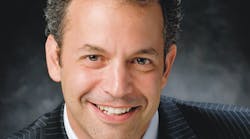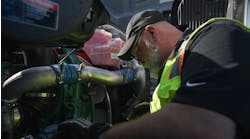Are you considered successful by most standards? If you are, you no doubt have wished you had more reliable means of achieving your desired outcomes without the uncertainties that managers and leaders inevitably experience from time to time.
The problem isn't you and you can't get more done by working longer and harder, maintains David Goldsmith, international consultant and advisor and president of the Goldsmith Organization - a leadership development organization (www.davidgoldsmith.com). "Rather, it's the lack of a leadership toolkit that enables you to maximize the potential of your greatest asset: your mind.
"The problem is that your plumber and front-line staffers have had more and better tools for doing their jobs and solving their daily challenges that you do."
Nevertheless, Goldsmith says decision makers can follow a practical approach to build a more effective leadership toolkit to help them be better at what they do.
That was the message he delivered to recent The Zone 2013, the inaugural fleet management conference put on by fleet telematics, remote diagnostics and mobile onboard computing company Zonar (www.zonarsystems.com), which I had the good fortune to attend.
Enterprise Thinking
Goldsmith talked about the lessons he developed on achieving transformational results through what he calls Enterprise Thinking. He details those lessons in his book, Paid to Think, A leader's toolkit for redefining your future.
Goldsmith defines Enterprise Thinking as "a leader's mental arsenal to technologically integrate all the tentacles of an organization for greater efficiencies and better outcomes."
Enterprise Thinking is composed of four categories: strategizing, learning, performing and forecasting, he told conference attendees. These activities need to be combined with his Economics of Thinking tool which illustrates the correlation between thinking and costs.
"Simply put," he explains, "the more a leader is to think through an idea before committing to action, the greater the chances an organization has to achieve higher returns, all while mitigating risk and reducing expense."
Managers and leaders are paid to think, he maintains, and as such ought to spend more time thinking about things before leaping into action. It is paramount to truly understand a situation or know the best options prior to making decisions.
Mimic Sports Coaches
Goldsmith's contention is that business success is 80 percent systems and structures and 20 percent people. The most important thing managers/leaders can do is to leverage technology to create sound systems and structures because these drive everything a business does by enabling employees to do their jobs more effectively.
Moreover, employees must be empowered, he adds. There are four steps to this:
1. Develop plans.
2. Build a structure and environment that supports the plan.
3. Transfer power to employees, work with them and teach them to learn and grow.
4. Monitor and adjust the process.
He suggests that managers/leaders should think of themselves as sports coaches who strategize and create playbooks and their staff as the players who execute under the coach's guidance. While trying out the "plays," get feedback from employees so plays can be modified to make them stronger.
Thinking into the Future
Obviously, the further managers/leaders can look into the future, the better they can anticipate what might come and prepare for that. Making a prediction about the future is easy. Making an accurate prediction about the future is very difficult.
The problem is that most people when talking about the future "put the topic into one massive outlook without knowing how to approach it," observes Goldsmith. Instead, he advises managers/leaders to get specific in forecasts by focusing thinking on the pieces rather than the whole using a tool he developed called the Pentality of Forecasting.
Just as a pentagon has five sides, this tool consists of five topic areas intended to direct and focus attention to key realistic factors affecting the long-term well-being of an organization, he explains. Those areas are:
1. You/your group/your organization. What is your personal future, your group's future and/or your organization's future?
2. Customer/client (member, patron, sponsor, etc.). What is the future of these or any downstream users or recipients of your work?
3. Competition. What are your direct, indirect and potential competitors' futures?
4. Supplier/vendor. What is the future of your suppliers/vendors or any alliance you have upstream or downstream that allows you to do what you do?
5. World/universe. What is happening globally that will impact the world or universe around you in ways that can influence you and your company's future?
The Current Reality
In summing up his remarks, Goldsmith reiterated his contention that leaders are paid to think and "today's thinking creates tomorrow.
"The current reality is a manifestation of all your past thinking-related activities as they are being played out by the lower-level managers and front-line staffers during execution-related activities, and this fact is the reason why having the right tools and the right thinking are essential to success."
A company's current reality is a manifestation of all managers'/leaders' past thinking-related decisions and activities made based on what was learned, strategized, performed and forecasted at the time, and how the execution-related activities are being played out by the lower-level managers and front-line staffers, he adds. This is the reason why having the right tools and the right thinking are essential to success.




